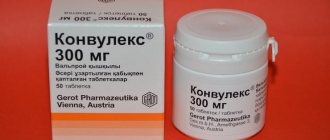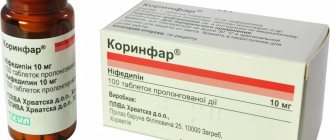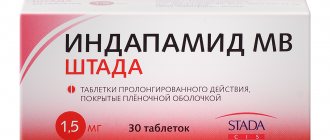Release form and composition
Fromilid uno is produced in the form of long-acting, film-coated tablets: biconvex, oval, marked U on one side; at the fracture, a brown-yellow film shell and a white or almost white rough mass stand out (in blisters of 5 pcs., 1 blister in a cardboard pack; in blisters of 7 pcs., in a cardboard pack 1 or 2 blisters).
1 tablet contains:
- active ingredient: clarithromycin – 500 mg (equivalent to the content of the active substance – 980–1020 mcg/mg);
- auxiliary ingredients: sodium calcium alginate, sodium alginate, lactose monohydrate, polysorbate-80, povidone, colloidal silicon dioxide, magnesium stearate, talc;
- film shell: hypromellose, yellow iron oxide dye (E 172), titanium dioxide (E 171), propylene glycol, talc.
Pharmacological properties
Pharmacodynamics
The active component of Fromilid uno is clarithromycin, a semisynthetic macrolide antibiotic that binds to the 50S ribosomal subunit and inhibits protein synthesis in bacteria sensitive to it.
In in vitro studies, clarithromycin is highly active against standard laboratory strains of bacteria and those isolated during clinical practice in patients, both aerobic and anaerobic, gram-positive and gram-negative. The MIC (minimum inhibitory concentration) of clarithromycin for most pathogens is on average one log2 dilution lower than the MIC of erythromycin.
In vitro, clarithromycin is highly active against Mycoplasma pneumoniae and Legionella pneumophila. It exhibits bactericidal activity against Helicobacter pylori, which increases with decreasing acidity of the medium and is higher for neutral pH than for acidic pH.
Data from in vitro and in vivo studies confirm that clarithromycin is active against clinically relevant mycobacterial species. Enterobacteriaceae and Pseudomonas spp., like other gram-negative bacteria that do not ferment lactose, are not sensitive to clarithromycin.
Microorganisms, the activity of clarithromycin against most of which has been proven both in vitro and in clinical practice:
- gram-positive aerobes: Staphylococcus aureus, Listeria monocytogenes, Streptococcus pyogenes, Streptococcus pneumoniae;
- gram-negative aerobes: Legionella pneumophila, Haemophilus influenzae/parainfluenzae, Neisseria gonorrhoeae, Moraxella catarrhalis;
- other infections: Chlamydia pneumoniae (including Taiwan acute respiratory agent - TWAR), Mycoplasma pneumoniae;
- mycobacteria: Mycobacterium chelonae, Mycobacterium kansasii, Mycobacterium leprae, Mycobacterium fortuitum; Mycobacterium avium complex (MAC), including Mycobacterium avium.
The activity of clarithromycin is not affected by the production of β-lactamase.
Most staphylococcal strains that are resistant to methicillin and oxacillin are also resistant to clarithromycin.
During a study of the sensitivity of Helicobacter pylori to clarithromycin on isolates isolated from 104 patients before the start of the drug, strains resistant to clarithromycin were isolated in 4 cases; in 2 – strains with moderate resistance; in the remaining 98 cases, clarithromycin was active against Helicobacter pylori isolates.
Strains of microorganisms against most of which clarithromycin is active in vitro (the safety and effectiveness of its use in clinical practice have not been confirmed by studies, so the practical significance remains unclear):
- gram-positive aerobes: Streptococci (groups C, F, G), Streptococcus agalactiae, Viridans group streptococci;
- gram-negative aerobes: Bordetella pertussis and Pasteurella multocida;
- gram-positive anaerobes: Clostridium perfringens, Propionibacterium acnes, Peptococcus niger;
- gram-negative anaerobes: Bacteroides melaninogenicus;
- Campylobacter: Campylobacter jejuni;
- spirochetes: Borrelia burgdorferi and Treponema pallidum.
The main metabolite of clarithromycin is 14-hydroxyclarithromycin (14-OH-clarithromycin), its microbiological activity is the same as that of the parent substance, or (for most microorganisms) two times weaker. Only in relation to Haemophilus influenzae the metabolite is twice as effective. Under both in vitro and in vivo conditions against Haemophilus influenzae, the parent compound with the main metabolite exhibits an additive effect or synergistic action (depending on the bacterial strain).
Pharmacokinetics
Clarithromycin is rapidly absorbed from the gastrointestinal tract (GIT). Its absolute bioavailability is about 50%. Due to repeated doses of Fromilid uno, practically no accumulation occurs, and the nature of metabolism remains almost unchanged.
The binding of clarithromycin to plasma proteins in vitro occurs by 70% in the range of drug doses of 0.45–4.5 μg/ml. At 45 μg/mL the binding rate decreases to 41%, possibly due to saturation of binding sites. This effect is observed only at concentrations many times higher than therapeutic.
Taking 1 tablet Fromilid uno (500 mg clarithromycin) 1 time per day after meals provides the maximum concentration in blood plasma (Cmax): clarithromycin - 1.3 μg/ml, its hydroxylated metabolite 14-OH-clarithromycin - 0.48 μg/ml . The half-life (T1/2) is 5.3 and 7.7 hours, respectively.
When taking a single dose of 1000 mg of clarithromycin (2 tablets of 500 mg), the Cmax of clarithromycin is 2.4, its metabolite is 0.67 mcg/ml. T1/2 is 5.8 and 8.9 hours, respectively. The time to reach maximum concentration (TCmax) when taking clarithromycin orally at a dose of both 500 and 1000 mg is about 6 hours. In comparison, it is clear that T1/2 of clarithromycin and its metabolite tends to lengthen with increasing doses, but Cmax 14-OH- clarithromycin did not increase in proportion to the dose of clarithromycin taken orally. Such indicators, combined with a decrease in the formation of 14-hydroxylated and N-demethylated products of clarithromycin at high dosages, indicate the nonlinear nature of its metabolism, which becomes more pronounced at high dosages.
~40% of an oral dose of clarithromycin is excreted by the kidneys; intestines ~ 30%.
Clarithromycin and its hydroxylated metabolite penetrate quickly into tissues and fluids. According to limited data, the level of clarithromycin in the cerebrospinal fluid when taken orally is insignificant and reaches only 1-2% of serum concentrations with normal permeability of the BBB (blood-brain barrier). The concentration in tissues is usually several times higher than the serum concentration.
In case of moderate to severe liver dysfunction, but with preserved renal function, no dosage adjustment is required. The steady-state concentration of clarithromycin in the blood (Css) and its systemic clearance do not differ from those in healthy patients. At the same time, the Css of clarithromycin metabolite in cases of impaired liver function is lower than in cases of normal liver function.
In cases of renal dysfunction, an increase in the concentration of clarithromycin (Cmax and Cmin) in the blood plasma is observed. As well as an increase in T1/2 and AUC of both clarithromycin and its metabolite (14-OH-clarithromycin). The elimination constant decreases, and the excretion of the substance by the kidneys decreases. The variability of these indicators depends on the degree of renal dysfunction.
In old age, the plasma concentration of clarithromycin and its active metabolite 14-OH-clarithromycin in the blood was higher, and the elimination rate was lower than in the control group of young patients. But after adjusting the dosage regimen taking into account creatinine clearance (CC), the difference was leveled out. Therefore, the pharmacokinetic parameters of the drug mainly change under the influence of renal function and do not depend on the age of the patient.
Pharmacokinetics
Suction
Clarithromycin is well absorbed from the gastrointestinal tract. Food slows absorption but does not significantly affect the bioavailability of clarithromycin.
Absorption of clarithromycin from extended-release tablets is delayed, but equivalent to absorption from immediate-release tablets in equal doses. Tmax increases. After reaching Cmax, the kinetics of both forms of clarithromycin (immediate-release tablets and extended-release tablets) are equivalent. Css is achieved by day 3. The bioavailability of extended-release tablets is 30% lower when taken on an empty stomach, so patients should take the extended-release form of clarithromycin with food.
Distribution
Clarithromycin easily penetrates into body tissues and fluids, where it reaches concentrations almost 10 times higher than serum concentrations.
Metabolism
Approximately 20% of clarithromycin is immediately metabolized to 14-hydroxy-clarithromycin, which has significant activity against Haemophilus influenzae.
Removal
T1/2 after taking a dose of 250 mg is 3-4 hours; after taking a dose of 500 mg is 5-7 hours. From 20 to 30% of clarithromycin (40% when taking a suspension) is excreted unchanged in the urine, the rest is excreted in the form of metabolites.
Pharmacokinetics in special clinical situations
The extended-release form of the drug is not recommended for patients with severe renal failure with CC < 0.5 ml/sec. In such patients, clarithromycin immediate-release tablets may be prescribed.
Contraindications
Absolute:
- Severe chronic renal failure (chronic renal failure) with CC less than 30 ml/min;
- severe liver failure, aggravated by renal failure;
- intrahepatic cholestasis and/or anamnestic evidence of cholestatic jaundice (hepatitis) due to the use of clarithromycin;
- porphyria;
- simultaneous therapy with astemizole, cisapride, pimozide, terfenadine, ergotamine (and other ergot alkaloids), oral midazolam, HMG-CoA reductase inhibitors (statins that are largely metabolized by the CYP3A4 isoenzyme, such as lovastatin, simvastatin - due to increased risk of myopathy, including rhabdomyolysis), colchicine, ticagrelor or ranolazine;
- history of congenital or documented prolongation of the QT interval on the electrocardiogram (ECG), ventricular arrhythmia or torsade de pointes;
- hypokalemia (due to the risk of prolongation of the QT interval on the ECG);
- lactase deficiency, lactose intolerance, glucose-galactose malabsorption;
- pregnancy in the first trimester;
- lactation (breastfeeding);
- age: when treating tonsillitis and acute otitis media – under 18 years of age; for other indications – under 12 years of age;
- hypersensitivity to macrolides, clarithromycin and other components of the drug.
Fromilid uno is taken with caution in the II–III trimesters of pregnancy, with mild to moderate renal failure (creatinine clearance more than 30 ml/min), moderate and severe liver failure, myasthenia gravis, coronary heart disease (coronary heart disease), severe heart failure, hypomagnesemia, severe bradycardia (less than 50 beats/min).
Caution should be exercised when using clarithromycin simultaneously with the following substances/drugs:
- benzodiazepines (triazolam, alprazolam, midazolam for intravenous administration);
- inducers of the CYP3A isoenzyme (carbamazepine, omeprazole, cyclosporine, cilostazol, disopyramide, methylprednisolone), indirect anticoagulants (warfarin), quinidine, rifabutin, tacrolimus, sildenafil, vinblastine;
- inducers of the CYP3A4 isoenzyme (carbamazepine, rifampicin, phenytoin, St. John's wort, phenobarbital);
- calcium channel blockers (CCBs), metabolized by the CYP3A4 isoenzyme (amlodipine, verapamil, diltiazem);
- other ototoxic drugs, especially aminoglycosides;
- statins that do not depend on the metabolism of the CYP3A4 isoenzyme (fluvastatin);
- antiarrhythmic drugs IA (procainamide, quinidine) and class III (amiodarone, dofetilide, sotalol).
Instructions for use Fromilid uno: method and dosage
The tablets are taken orally, during meals, without chewing or breaking, swallowing whole.
Recommended daily dosage: children over 12 years of age and adult patients - Fromilid uno 500 mg (1 tablet) 1 time per day.
For the treatment of tonsillitis and otitis media, the drug is prescribed only to adult patients over 18 years of age - Fromilid uno 500 mg (1 tablet) 1 time per day.
In case of severe disease, the dose is increased to 1000 mg (2 tablets) 1 time per day.
The standard duration of treatment is 5–14 days, with the exception of therapy for community-acquired pneumonia and sinusitis, which require treatment for a minimum of 6 to 14 days.
Indications
Indications for the use of Fromelid Uno are a number of infectious diseases caused by bacteria that are sensitive to clarithromycin:
- Infectious diseases of the respiratory system (pharyngitis, tonsillitis, sinusitis, bronchitis, as well as pneumonia (including atypical)).
- Otitis.
- Infectious diseases of soft tissues and skin, which are caused by bacteria sensitive to clarithromycin.
- Mycobacteriosis (except tuberculosis).
- Complex therapy of infectious gastritis and gastric or intestinal ulcers (destruction of Helicobacter pylori).
- Preventive therapy for AIDS.
Side effects
Classification of the World Health Organization (WHO) to determine the frequency of side effects: very often - not less than 0.1%; often - from 0.01 to 0.1%; infrequently – from 0.001 to 0.01%; rarely - from 0.0001 to 0.001%; extremely rare - less than 0.0001%, including isolated cases; with uncertain frequency – it is impossible to estimate the frequency based on the available data.
Frequency of side effects due to taking Fromilid uno from systems and organs:
- digestive system: often - nausea, dyspepsia, abdominal pain, increased activity of liver enzymes; uncommon – diarrhea, vomiting, stomatitis, glossitis, candidiasis of the oral mucosa, acute pancreatitis, discoloration of tooth enamel and tongue, hepatocellular/cholestatic hepatitis, pseudomembranous colitis, cholestatic jaundice, anorexia, dry oral mucosa, constipation, flatulence, belching , gastritis; extremely rare - liver failure with a fatal outcome, mainly due to concomitant severe diseases and/or simultaneous administration of other drugs;
- skin and subcutaneous tissue: often – hyperhidrosis; with an unknown frequency - acne, drug rash (including with eosinophilia and systemic symptoms), erysipelas, erythrasma;
- nervous system: often – headache; uncommon – drowsiness, paresthesia, anxiety, convulsions, hallucinations, psychosis, confusion, dizziness, fear, nightmares, insomnia, depersonalization, tremor, disorientation, depression; with an uncertain frequency - mania;
- sensory organs: often – dysgeusia (distortion/loss of taste); infrequently - noise (ringing) in the ears, up to hearing loss (recovered after discontinuation of Fromilid uno), vertigo; extremely rarely - cases of impaired sense of smell;
- cardiovascular system: uncommon - ventricular tachycardia, including pirouette-type arrhythmia, ventricular flutter/fibrillation, prolongation of the QT interval on the ECG;
- hematopoietic system: rarely - thrombocytopenia (unusual hemorrhages, bleeding), leukopenia; with an unknown frequency - agranulocytosis;
- musculoskeletal system: uncommon – arthralgia, myalgia; with an unknown frequency - myopathy;
- urinary system: uncommon – interstitial nephritis; with an unknown frequency - renal failure;
- allergic reactions: uncommon - skin itching/rash, skin flushing, urticaria, Stevens-Johnson syndrome (malignant exudative erythema), Lyell's syndrome (toxic epidermal necrolysis), anaphylaxis; with an uncertain frequency - Henoch-Schönlein purpura;
- laboratory test data: infrequently - increased creatinine concentration, hypoglycemia (including when used simultaneously with hypoglycemic drugs), increased alkaline phosphatase (ALP) activity, increased bilirubin levels; with uncertain frequency - increased international normalized ratio (INR), prolongation of prothrombin time;
- other reactions: secondary infections (development of resistance to microorganisms); infrequently - asthenia.
How to choose the most effective antibiotic
Which antibiotic to choose? The use of antibacterial agents for tonsillitis is regulated by national and international recommendations, which are based on evidence-based medicine . According to them, only a qualified doctor can prescribe antibiotics, since self-administration of these medications has much lower effectiveness. A list of drugs that should be prescribed is also highlighted.
Before starting to use medications, you need to make sure that inflammation of the tonsils is of bacterial origin, since they account for only 30% of all cases. Prescribing antibiotics for viral sore throat is completely ineffective. For this purpose, the doctor conducts a thorough examination of the patient, prescribes general blood and urine tests and a bacteriological examination of a smear from the oropharynx. The latter method also allows you to determine which antibiotics act on pathogenic flora.
First and second line drugs
According to current recommendations, protected penicillins remain the drugs of choice for bacterial tonsillitis, and especially the combination of amoxicillin with clavulanic acid (trade name Amoxiclav, Augmentin). They are prescribed to all patients of any age in the absence of an allergy to the medication, as well as if they have not used penicillins for the last 3 months.
Monitoring the effectiveness of antibacterial therapy is needed 72 hours after its start. It is carried out based on the following clinical and laboratory criteria:
normalization of body temperature (or decrease in its indicators);
reducing the severity of general intoxication syndrome (headache, palpitations, general weakness, restoration of appetite);
reducing the intensity of sore throat;
reducing the number of “purulent plugs” on the tonsils, reducing their swelling;
Overdose
Symptoms of an overdose of clarithromycin when taken orally in large doses are gastrointestinal disorders. Mental status changes, paranoid behavior, hypoxemia, and hypokalemia were reported in a patient with a history of bipolar disorder following administration of 8000 mg clarithromycin.
It is recommended to take measures to evacuate the unabsorbed drug from the gastrointestinal tract (inducing vomiting, gastric lavage, taking activated charcoal, etc.) and carrying out symptomatic treatment. For drugs from the group of macrolides, including clarithromycin, hemo- and peritoneal dialysis has been proven to be ineffective in reducing their concentration in the blood serum.
Interaction with other drugs
Concomitant use of the drug with drugs from other pharmacological groups may lead to changes in therapeutic effects or the development of negative reactions:
- Terfenadine, cisapride, pimozide and astemizole can lead to the development of severe arrhythmia, therefore Fromilid uno 500 is contraindicated when using them.
- Changes in the therapeutic effectiveness of oral anticoagulants (warfarin).
- Reduced adsorption of the antiviral agent zidovudine.
- Ritonavir causes a significant increase in clarithromycin blood concentrations.
special instructions
A consequence of prolonged use of antibiotics may be the formation of colonies with an increased number of resistant bacteria and fungi, the so-called superinfection, which requires appropriate therapy.
There have been reports of cases of hepatic dysfunction with increased activity of liver enzymes in the blood plasma and hepatocellular/cholestatic hepatitis with or without jaundice during the use of clarithromycin. Liver dysfunction can progress to severe levels, but is usually reversible. Fatal liver failure has been reported, mainly associated with the presence of serious concomitant diseases and/or concomitant use of other drugs. The appearance of signs/symptoms of hepatitis (itching, jaundice, anorexia, dark urine, abdominal tenderness on palpation) requires immediate cessation of therapy. In patients with chronic liver diseases, it is necessary to regularly monitor the activity of liver enzymes in the blood serum.
Therapy with almost any antibacterial agent, including clarithromycin, can cause mild to life-threatening pseudomembranous colitis. Since antibacterial drugs can change the normal intestinal microflora, as a result of which the growth of the main causative agent of pseudomembranous colitis, Clostridium difficile, increases. The disease should be suspected in all patients if diarrhea develops after the use of antibacterial drugs. Upon completion of a course of antibiotic therapy, the patient requires careful medical supervision. There have been reports of the development of pseudomembranous colitis two months after the end of antibiotic treatment.
The use of macrolides, including clarithromycin, prolongs the period of myocardial repolarization and the QT interval, increasing the risk of developing cardiac arrhythmia (including torsade de pointes).
It is possible that cross-resistance may develop towards clarithromycin and other macrolide antibiotics, as well as clindamycin and lincomycin.
Due to the increasing resistance of Streptococcus pneumoniae to macrolides, it is important to conduct sensitivity testing when prescribing clarithromycin for the treatment of patients with community-acquired pneumonia. In patients with hospital-acquired pneumonia, clarithromycin is used in combination with appropriate antibiotics.
Most often, mild to moderate skin and soft tissue infections are caused by Staphylococcus aureus and Streptococcus pyogenes. Both pathogens can exhibit resistance to macrolides. Therefore, it is important to conduct a test to determine the spectrum of their sensitivity to antibiotics.
Antibiotics of the macrolide group can be used to treat infections caused by Corynebacterium minutissimum, diseases of acne vulgaris and erysipelas, as well as when it is impossible to use penicillin.
In case of acute hypersensitivity reactions [anaphylaxis, Stevens-Johnson syndrome, Lyell's syndrome, drug rash with eosinophilia and systemic symptoms (DRESS syndrome)], it is necessary to immediately stop taking clarithromycin and carry out symptomatic therapy.
When using clarithromycin concomitantly with warfarin or other indirect anticoagulants, INR and prothrombin time (PT) should be monitored.
Impact on the ability to drive vehicles and complex mechanisms
The possibility of side effects of clarithromycin, such as dizziness, vertigo, confusion and disorientation, should be taken into account when performing potentially hazardous types of work, including driving vehicles and other complex machinery.
Pharmacodynamics
Clarithromycin is a semisynthetic macrolide containing 14 carbon atoms. The properties of clarithromycin are similar to eryromycin, of which it is a derivative. However, the methoxy group in the lactone ring gives the active substance acid resistance and improved antibacterial properties compared to its predecessor.
Thus, clarithromycin is not destroyed and does not lose its properties under the influence of hydrochloric acid in the human stomach. However, the maximum activity of the drug is achieved when it acts in an alkaline environment. These properties of the drug formed the basis for the treatment of gastritis and stomach ulcers (the stage of destroying the pathogen Helicobacter pylori).
The mechanism of the antibacterial action of the drug is based on its ability to inhibit the process of protein biosynthesis in the cell walls and cytoplasm of bacteria. Clarithromycin has both bactericidal (at high levels) and bacteriostatic effects on microbial cells.
Pathogenic organisms that exhibit sensitivity to clarithromycin: the main types of Gram-positive and negative bacteria, anaerobic and mycobacteria (with the exception of Mycobacterium tuberculosis).
Use during pregnancy and lactation
The safety of clarithromycin use in pregnant and lactating women has not been reliably established.
During pregnancy (especially in the first trimester), taking Fromilid uno is possible only in the absence of alternative therapy and a clinically significant excess of the potential benefit to the mother over the probable risk to the fetus.
Clarithromycin passes into breast milk in small quantities, and therefore breastfeeding should be discontinued during therapy.
Reviews of Fromilid uno
According to reviews, Fromilid uno is a very effective drug for the rapid treatment of severe and advanced infections. There are practically no cases of adverse reactions described, except for isolated mentions of stomach problems that may have arisen as a result of non-compliance with recommendations for taking pills.
The disadvantages of Fromilid uno include the large size of the tablets, extensive instructions with a large number of contraindications and side effects, and the cost - according to some patients, quite high.





